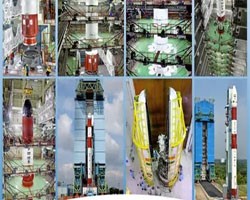Banking Current Affairs
| Science and Technology |
|---|
|
|
|
Context:
India’s space program is set to achieve another milestone as the Indian Space Research Organisation (ISRO) launches the PSLV C60/SpaDeX mission to demonstrate in-space docking technology, a critical step for future interplanetary and satellite servicing missions. Space Docking Experiment (SpaDeX) Overview: The mission will demonstrate space docking technology using two small satellites, Chaser (SDX01) and Target (SDX02), which will attempt docking in early January 2025. This experiment is essential for developing capabilities in spacecraft rendezvous, docking, and undocking, paving the way for advanced space missions. Significance: SpaDeX marks a significant step toward futuristic space endeavors such as: Satellite servicing (e.g., repairing or refueling satellites in orbit). Space station operations (e.g., constructing and maintaining an Indian space station). Interplanetary missions (e.g., sample return from the Moon and sending Indian astronauts to the Moon). Mission Details Launch Vehicle: Polar Satellite Launch Vehicle (PSLV-C60). Launch Time and Location: 9:58 p.m., December 30, 2024, from the Satish Dhawan Space Centre, Sriharikota. Payload: Two small satellites weighing 220 kg each, deployed into a 470-km circular orbit with a 55-degree inclination. Docking Process Deployment: SDX02 (Target) will separate 15 minutes after launch. SDX01 (Chaser) will separate a few seconds later. Inter-Satellite Separation: The launch vehicle will provide a small incremental velocity to establish a 10-20 km distance between the satellites within a day. Drift Arrest Manoeuvre: Using its propulsion system, the Target spacecraft will stabilize in orbit with respect to the Chaser. Far Rendezvous and Approach: The Chaser will gradually approach the Target in stages, reducing inter-satellite distances incrementally. Docking: Final docking of the two spacecraft is expected in the first week of January 2025. Features of SpaDeX Technological Advancements: Demonstrates precise orbital maneuvers and velocity adjustments for inter-satellite operations. Critical for modular spacecraft design and space station assembly. Payload: Includes 24 PS4-Orbital Experiment Module payloads for scientific experiments. Significance of SpaDeX Future Space Missions: Enables critical technologies for India’s ambitious space projects, including manned lunar missions and building an Indian space station. Global Competitiveness: Positions India as a significant player in space exploration, capable of undertaking complex interplanetary missions. Technological Leadership: Advances capabilities in docking, a challenging technology mastered by only a few nations. Challenges Precision Maneuvers: Accurate deployment and velocity adjustments require advanced control systems. Orbital Dynamics: Synchronizing the orbits of two spacecraft with minimal error is highly complex. Reliability: Ensuring the docking mechanism performs flawlessly in space conditions. Conclusion The SpaDeX mission represents a crucial milestone in ISRO’s journey to enhance India’s space capabilities. By mastering space docking technology, ISRO is paving the way for more sophisticated missions, reaffirming India’s position as a leader in the global space community. Source: The Hindu |
|
|
|
Useful information for all competitive exams:
Indian Space Research Organisation (ISRO): Formed: 15 August 1969 Preceding agency: INCOSPAR (1962–1969) Headquarters: Bengaluru, Karnataka Chairman: S. Somanath (10th Chairman of the Indian Space Research Organisation) Primary spaceports: Satish Dhawan Space Centre, Thumba Equatorial Rocket Launching Station, Kulasekarapattinam Spaceport |
| >> More Banking Current Affairs |
